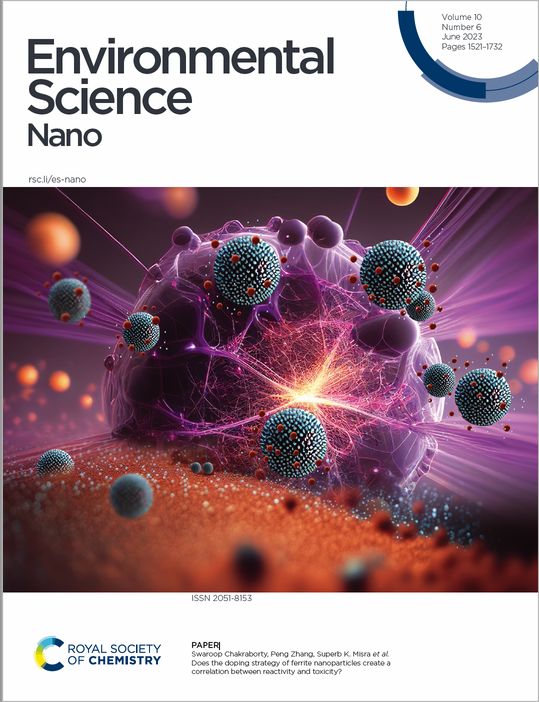
Congratulations:
- 2024: Bharti for successfully defending her PhD thesis.
- 2023: Simranjit Singh for successfully defending his PhD thesis.
- 2023: Pahuni for getting outstanding B.Tech. Research award.
- 2023: BNMG Lab for getting a GSBTM grant
- 2023: Prateek Goyal for successfully defending his PhD thesis.
- 2022: Dhruv for getting outstanding B.Tech. Research award.
- 2022: Bharti Malvi for receiving SERB grant for the 5th International Conference on Applied Surface Science, Spain.
- 2022: Simranjit for presenting his work at HYMA2022 (Materials Today), Italy
- 2022: Bharti for presenting her work at 7th International Conference on Ion Beams in Materials Engineering and Characterization (IBMEC 2022), Inter-University Accelerator Centre, Delhi.
- 2021: Prateek Goyal for presenting his work at NANO2021 (NanoToday), China.
- 2021: Bharti for presenting her work at 3rd Global Virtual Summit on “Advances in Materials, Physics and Chemistry Science”, Delhi.
- 2021: Anurag Sharma, for his PhD selection at NTU, Singapore.
- 2021: Archini Paruthi for successfully defending her PhD thesis.
- 2021: Swaroop Chakraborty for successfully defending his PhD thesis
- 2020: Ranga Teja, Saurabh Soni and Ankit Jaiswal for successfully defending their M.Tech thesis.
- 2019: Ranga Teja for his PhD selection at The University of Louisville, Kentucky.
- 2019: BNMG group for securing SERB-CRG grant on nanotheranostics.
- 2019: Bharti Malvi, for successfully defending her proposal for accessing the Inter-University Accelerator Center for ion implantation work.
- 2018: Swaroop Chakraborty for getting "IITGN Overseas Scholarship" award for an internship at Univ. Birmingham, UK.
- 2018: Ankit Jaiswal for being awarded India Connect Research Internship Programme from NTU, Singapore
- 2018: Saurabh Soni for getting selected in the IITGN-JAIST M.Tech-MS Dual Degree program.
- 2019: Swaroop Chakraborty for presenting a poster at 6th Nano Today Conference, Portugal.
- Archini Paruthi for receiving "IITGN Overseas Scholarship" to pursue an internship in USA
Environmental Applications

Water treatment to remove heavy metals, (e.g. Cd, Pb, Cr) is our lab's focus. Our research basically focuses on synthesis of metal oxide nanocomposites, metal organic frameworks (MOFs) and hybrid materials for environmental applications.
Bionanomaterials
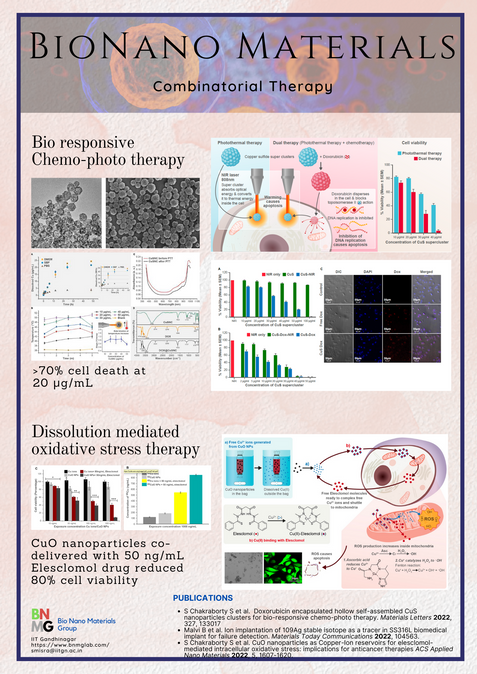
Our research goal is to use combinatorial aspects (dissolution mediated, hyperthermia, photothermal etc) to treat cells and develop platforms that help in tissue regeneration.
Nanosafety
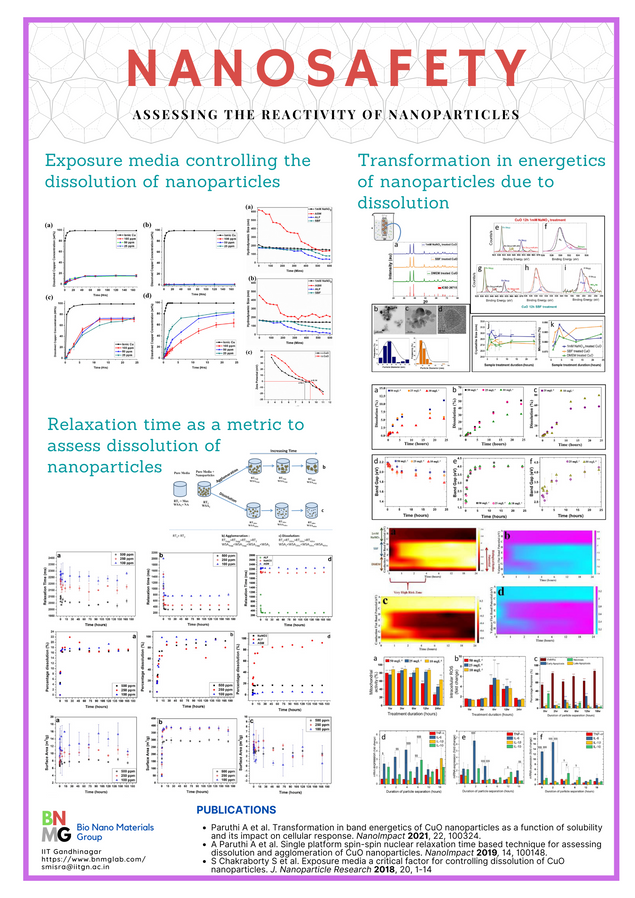
Reactivity of nanoparticles (ENPs) is an important property that alters their abundance and is critical in determining their safety. The dissolution status of the ENPs in exposure media, strongly affects the uptake pathway, toxicity mechanisms. Our group studies the toxicological potential of ENPs
Labelling of Nanomaterials
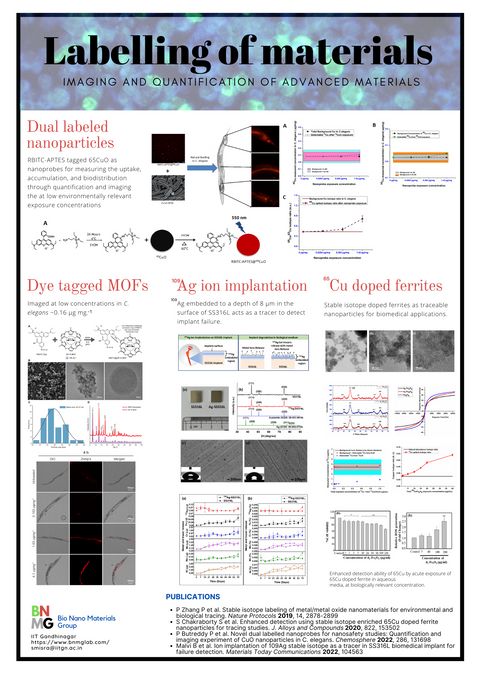
Engineered nanoparticles (ENPs) are being extensively produced and used in various sectors. During their production, use and disposal the MENPs release into the environment and emerge as contaminants. Our lab focuses on labelling the ENPs with fluorescent probes and stable isotopes for tracing studies
PhD: Imperial College London, 2007
ARUNIMA tHOTTATHIL
PhD Scholar - IIT Gandhinagar
23310065(at)iitgn.ac.in
Research Interests:
- Biomedical applications of MOF
ARjit kumar
MTech Student - IIT Gandhinagar
arjit.kumar(at)iitgn.ac.in
Research Interests:
- Environmental applications of MOF
Alumni
- Dr. Bharti Malvi - Ph.D. Material Sci.& Engineering (2024)
- Dr. Simranjit Singh - Ph.D. Material Sci.& Engineering (2023)
- Dr. Prateek Goyal - Ph.D. Material Sci.& Engineering (2023)
- Dr. Swaroop Chakraborty - Ph.D. Biological Engineering (2021)
- Dr. Archini Paruthi - Ph.D. Material Sci.& Engineering (2021)
- Kerthy V- M.Tech Materials Engineering (2022)
- Anurag Sharma- M.Tech Material Sci.& Engineering (2021)
- Saurabh Soni- M.Tech Material Sci.& Engineering (2020)
- Ankit Jaiswal- M.Tech Material Sci.& Engineering (2020)
- Pravalika Buttreddy - M.Tech Material Sci.& Engineering (2019)
- Saurabh Sharma - M.Tech Material Sci.& Engineering (2019)
- Seema Negi- M.Tech Material Sci.& Engineering (2016)
Alumni
- Pahuni Jain - B. Tech Chemical Engineering (2023)
- Dhruv Menon - B. Tech Material Sci.& Engineering (2022)
- VVS Akhil- B. Tech Material Sci.& Engineering (2020)
- Aman Singh- B.Tech Material Sci.& Engineering (2019)
- Ankita Joshi- B.Tech Material Sci.& Engineering(2017)
- Kaustubh Panse- B.Tech Material Sci.& Engineering (2017)
- Barath K. Mahadevan- B.Tech Material Sci.& Engineering (2017)
- Akshay Randad - B.Tech Mechanical Engineering (2014)
- Pallawi Gupta- PGDIIT (2017)
- Geethanjali S. Dakhsinamurthy - PGDIIT (2016)
60. Bhadane P et al. Hydrolytically stable nanosheets of Cu-Imidazolate MOF for selective trapping and simultaneous removal of multiple heavy metal ions. Env. Sci.: Nano. 2024.
59.Singh S et al. Enhanced therapeutic action of Trastuzumab loaded ZnxMn1−xFe2O4nanoparticles using a pre-treatment step for hyperthermia treatment of HER2+ breast cancer. Colloids and Surfaces B: Biointerfaces. 2023. 232, 113579.
58. Malvi B, et al. Development of isotopically labelled 65Cu embedded PMMA-65CuO nanocomposites for detection and quantification of PMMA bone cement degradation at trace levels. Materials Today: Comm. 2023. 36, 106849.
57. S Singh, et al. Synergistic Effect of Yb3+, Tm3+, Nd3+ Doped NaYF4 Nanoparticles and MoS2 Nanosheets for Enhanced Photocatalytic Dye Degradation under Visible Light. ACS App. Nano Mater. 2023, 6,10441.
56. Chakraborty S, et al. Does the doping strategy of ferrite nanoparticles create a correlation between reactivity and toxicity? Env. Sci.: Nano. 2023, 10, 1553-1569.
55. Goyal P, et al. Linker mediated enhancement in reusability and regulation of Pb(II) removal mechanism of Cu-centered MOFs. Sep. Pur. Technol. 2023, 318, 123941.
54. S Chakraborty S, et al. CuO nanoparticles as Copper-Ion reservoirs for elesclomol-mediated intracellular oxidative stress: implications for anticancer therapies. ACS App. Nanomater. 2022, 5, 1607-1620
53. Malvi B, Chaudhari R, Balasubramanian C, Kumar A, Asokan K, Das S, Paliwal M, Misra SK*. Ion implantation of 109Ag stable isotope as a tracer in SS316L biomedical implant for failure detection. Mater. Today: Comm. 2022, 33, 104563.
52. Chakraborty S, Prasad R, Pandey P, Khan A, Jain NK, Valsami Jones E, Srivastava R, Misra SK*. Doxorubicin encapsulated hollow self-assembled CuS nanoparticles clusters for bio-responsive chemo-photo therapy. Mater Lett. 2022, 327, 133017.
51. Prateek Goyal, et al. Toxicological Impact and in Vivo Tracing of Rhodamine Functionalised ZIF-8 Nanoparticles, Front. Toxicol. 2022; 4: 917749.
50. Shivanand H Nannuri, et al. Microwave-assisted synthesis and upconversion luminescence of NaYF4:Yb, Gd, Er and NaYF4:Yb, Gd, Tm nanorods, Meth App. Fluor. 2022, 10, 024004.
49. Prateek Goyal, et al. Fe doped bimetallic HKUST-1 MOF with enhanced water stability for trapping Pb(II) with high adsorption capacity, Chem. Engg. J. 2022, 133088.
48. Pravalika Butreddy, et al. Novel dual labelled nanoprobes for nanosafety studies: Quantification and imaging experiment of CuO nanoparticles in C. elegans, Chemosphere, 2022. 286, 131698.
47. Simranjit Singh. et al. Enhanced Visible/NIR driven catalytic activity in presence of neodymium (Nd3+), for Yb3+ and Tm3+ doped NaYF4 nanoparticles. J. Environ. Chem Engg., 2021, 105813.
46. Archini Paruthi, et al. Transformation in band energetics of CuO nanoparticles as a function of solubility and its impact on cellular response. NanoImpact, 2021, 22, 100324.
45. Prateek Goyal, et al. Ion exchange based approach for rapid and selective Pb(II) removal using iron oxide decorated metal-organic framework hybrid. J. Environ. Manag. 2021, 277, 11146.
44. Juhi Shah, et al. BSA-Decorated Magnesium Nanoparticles for Scavenging Hydrogen Peroxide from Human Hepatic Cells. ACS Appl. Nano Mater, 2020, 3, 4, 3355–3370.
43. Chakraborty S., et al. Enhanced detection using stable isotope enriched 65Cu doped ferrite nanoparticles for tracing studies. J. Alloy. Comp., 2020, 153502.
42. Kansara, K., et al. Montmorillonite clay and humic acid modulate the behavior of copper oxide nanoparticles in aqueous environment and induces developmental defects in zebrafish embryo. Environ. Poll., 2019, 255, 113313.
41. Chakraborty S. A comparative analysis of dialysis based separation methods for assessing copper oxide nanoparticle solubility. Environ Nanotechnol. Monitor. Manag., 2019, 12, 100258.
40. Zhang P, et al. Stable isotope labeling of metal/metal oxide nanomaterials for environmental and biological tracing. Nature Protocols 2019, 1-22.
39. Paruthi A, et al. Single platform spin-spin nuclear relaxation time (1H NMR) based technique for assessing dissolution and agglomeration of CuO nanoparticles. NanoImpact, 2019, 14, 100-148.
38. Chakraborty S, et al. Exposure Media a critical factor for controlling dissolution of CuO. Nanoparticles. J. Nanopart. Res. 2018, 20(12),331
37. Goyal P, et al. Multifunctional Fe3O4-ZnO nanocomposites for environmental remediation applications. Environ. Nanotechnol. Monitor. Manag., 2018. 10, 28-35.
36. Paruthi A, Relaxation time: a proton NMR based approach as a metric to measure reactivity of engineered nanomaterials. J. Nanopart. Res., 2017, 19(8), 292
35. Chakraborty S, et al. Tailoring of physicochemical properties of nanocarriers for effective anti-cancer applications. J. Biomed. Mater. Res. Part A. 2017, 105(10); 2906-2908
34. Piret J-P, et al. Pan-European interlaboratory studies on a panel of in-vitro cytotoxicity and proinflammation assays of nanoparticles. Arch. Toxicol., 2017, 91 (6); 2315-2330
33. Karbowniczek J, et al. Electrophoretic deposition of organic/inorganic coatings containing ZnO nanoparticles exhibiting antibacterial properties. Mater. Sci. Engg. C, 2017, 77; 780-789
32. Zou J, et al. Micro CT visualization of silver nanoparticles in the middle and inner ear of rat and transportation pathway after transtympanic injection. J Nanobiotechnology 2015, 13; 1-9.
31. Khan FR, et al. Inhibition of potential uptake pathways for silver nanoparticles in the estuarine snail Peringia ulvae. Nanotoxicology 2015, 9; 493-501.
30. Cordero-Arias L, et al. Electrophoretic deposition of ZnO/alginate and ZnO-bioactive glass/alginate composite coatings for antimicrobial applications. Mater. Sci. Engg. C 2015, 55; 137-44.
29. Sweeney S, et al. Multi-walled carbon nanotube length as a critical determinant of bioreactivity with primary human pulmonary alveolar cells. Carbon 2014, 78; 26-37.
28. Croteau MN, et al. Bioaccumulation and toxicity of CuO nanoparticles by a freshwater invertebrate after waterborne and dietborne exposures. Environ. Sci. Technol. 2014, 48; 10929-10937.
27. Croteau MN, et al. Isotopically modified silver nanoparticles to assess nanosilver bioavailability and toxicity at environmentally relevant exposures. Environ. Chem. 2014, 11; 247-56.
26. Misra SK, et al. Comparative study using spheres, rods and spindle-shaped nanoplatelets on dispersion stability, dissolution and toxicity of CuO nanomaterials. Nanotoxicology 2014, 8; 422-32.
25. García-Alonso J, et al. Toxicity and accumulation of silver nanoparticles during development of the marine polychaete Platynereis dumerilii. Sci. Total Env. 2014, 476; 688-95.
24. Pang C, et al. Bioaccumulation, toxicokinetics, and effects of copper from sediment spiked with aqueous Cu, nano‐CuO, or micro‐CuO in the deposit‐feeding snail, Potamopyrgus antipodarum. Env. Toxicol. Chem. 2013, 32; 1561-73.
23. Bucchianico SD, et al. Multiple cytotoxic and genotoxic effects induced in vitro by differently shaped copper oxide nanomaterials. Mutagenesis 2013, 28; 287-99.
22. Misra SK, et al. The complexity of nanoparticle dissolution and its importance in nanotoxicological studies. Sci. Total Environ. 2012, 438; 225-32.
21. Khan FR, et al. Bioaccumulation dynamics and modeling in an estuarine invertebrate following aqueous exposure to nanosized and dissolved silver. Environ. Sci. Technol. 2012, 46; 7621-28.
20. Pang C, et al. Effects of sediment-associated copper to the deposit-feeding snail, Potamopyrgus antipodarum: A comparison of Cu added in aqueous form or as nano-and micro-CuO particles. Aquatic Toxicol. 2012, 106; 114-22.
19. Misra SK, et al. Isotopically modified nanoparticles for enhanced detection in bioaccumulation studies. Environ. Sci. Technol. 2011, 46; 1216-22.
18. Croteau MN, et al.. Silver bioaccumulation dynamics in a freshwater invertebrate after aqueous and dietary exposures to nanosized and ionic Ag. Environ. Sci. Technol. 2011, 45; 6600-7.
17. García-Alonso J, et al. Cellular internalization of silver nanoparticles in gut epithelia of the estuarine polychaete Nereis diversicolor. Environ. Sci. Technol. 2011, 45; 4630-36.
16. Dybowska A, et al. Synthesis of isotopically modified ZnO nanoparticles and their potential as nanotoxicity tracers. Environ.Poll. 2011, 159; 266-73.
15. Misra SK, et al. Poly (3-hydroxybutyrate) multifunctional composite scaffolds for tissue engineering applications. Biomaterials 2010, 31; 2806-15.
14. Misra SK, et al. Characterization of carbon nanotube (MWCNT) containing P (3HB)/bioactive glass composites for tissue engineering applications. Acta Biomater. 2010, 6; 735-42.
13. Misra SK, et al. Effect of nanoparticulate bioactive glass particles on bioactivity and cytocompatibility of poly (3-hydroxybutyrate) composites. J. Royal Soc. Interf. 2010, 7; 453-65.
12. Berhanu D, et al. Characterisation of carbon nanotubes in the context of toxicity studies. Environ. Health 2009, 8; S3.
11. Bretcanu O, et al. Electrospun nanofibrous biodegradable polyester coatings on Bioglass based glass-ceramics for tissue engineering. Mater. Chem. Phys. 2009, 118; 420-26.
10. Misra SK, et al. Incorporation of vitamin E in poly (3hydroxybutyrate)/Bioglass composite films: effect on surface properties and cell attachment. J. Royal Soc. Interf. 2009, 6; 401-9.
9. Bretcanu O, et al. In vitro biocompatibility of 45S5 Bioglass®‐derived glass–ceramic scaffolds coated with poly (3‐hydroxybutyrate). J. Tissue Engg. Reg. Med. 2009, 3; 139-48.
8. Misra SK, et al. Comparison of nanoscale and microscale bioactive glass on the properties of P (3HB)/Bioglass composites. Biomaterials 2008, 29; 1750-61.
7. Valsami-Jones E, et al.Nanomaterial synthesis and characterization for toxicological studies: TiO2 case study. Mineralogical Mag. 2008, 72; 515-9.
6. Valappil SP, et al. Large-scale production and efficient recovery of PHB with desirable material properties, from the newly characterised Bacillus cereus SPV. J. Biotech. 2007, 132; 251-8.
5. Bretcanu O, et al. Biodegradable polymer coated 45S5 Bioglass derived glass-ceramic scaffolds for bone tissue engineering. Glass Technology-European Journal of Glass Science and Technology Part A 2007, 48; 227-34.
4. Misra SK, et al. Fabrication and characterization of biodegradable poly (3-hydroxybutyrate) composite containing bioglass. Biomacromolecules 2007, 8; 2112-9.
3. Valappil SP, et al. Biomedical applications of polyhydroxyalkanoates, an overview of animal testing and in vivo responses. Exp. Rev. Med. Dev. 2006, 3; 853-68.
2. Misra SK, et al. Poly (3-hydroxybutyrate)/ Bioglass® composite films containing carbon nanotubes. Nanotechnology 2007, 18; 075701.
1. Boccaccini AR et al. Electrophoretic deposition of polyetheretherketone (PEEK) and PEEK/Bioglass® coatings on NiTi shape memory alloy wires. J. Mater. Sci. 2006, 41; 8152-9.
LAB FACILITIES
- Positive Pressure Lab
- Hydrothermal Synthesis
- Vacuum Oven
- Hyperthermia
- Xigo-Benchtop NMR
- Sonicator
- Benchtop Centrifuge
- Dynamic Light Scattering
- Cell culture facility
- 980 nm laser set-up
- UV exposure chamber
- Incubator Chamber
Department FACILITIES
- Metallography Lab
- Processing Lab
- Microbiology Lab
- Characterisation Lab
- Mechanical Testing Lab
- Thermal Lab
- Surface Lab
- Compositional Lab
INSTITUTE FACILITIES
- SEM
- TEM
- ICP-OES/ICP-MS
- PXRD, GI-XRD, SC-XRD
- Micro-CT
- XPS
- NMR
- FACS
- PPMS
- MALDI


Bionanomaterials group (BNMG) is an interdisciplinary research group focusing on the application of materials science for biological and environmental applications. BNMG is conducting research on exploiting the uniqueness of engineered materials and tailoring their properties. In addition, research activities are also directed towards understanding the intrinsic properties of novel materials and using them to get a predictive impact, for cellular and environmental research.

Funded by:

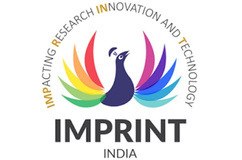
Contact us
Office: Academic Block 11/306B
Lab: Academic Block 5/208
Materials Engineering
Indian Institute of Technology Gandhinagar
Palaj, Gandhinagar - 382355
Gujarat, India
